The Physics of a New Generation
How a fundamental but unstable particle might be our first window into particle physics beyond the Standard Model.
Image credit: Muon g-2 magnet, courtesy of Fermilab.
“You suddenly realize that you and your colleagues know something that no one else does… and that it is important. You’re lucky if it happens once in a lifetime. I’ve been super-lucky.” –Leon Lederman
When it comes to fundamental physics, we’ve come a long way in a very short amount of time. In a little over a century, we’ve discovered that what we once thought was the fundamental, smallest unit of matter — the atom — is actually made up of even smaller particles: nuclei and electrons. The nuclei themselves are made of protons and neutrons, and those protons and neutrons are made of still smaller particles: quarks and gluons!
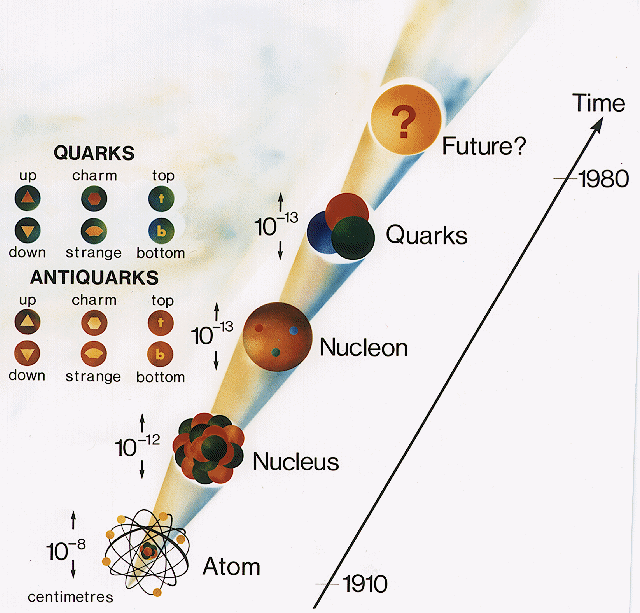
Those particles — quarks, gluons, and electrons — are just some of the particles that cannot be broken up into smaller constituents to the best of our knowledge. All told, when we count up the fundamental particles that we know of, the ones that cannot be broken apart into anything smaller or lighter, we count a number of different types:
- six quarks (and their antiquark counterparts), each coming in three different color possibilities and two different spins,
- three charged leptons, the electron, muon and tau (and their anti-lepton counterparts), each allowed two different spin states,
- three neutral leptons, the neutrinos, along with the three anti-neutrinos, where the neutrinos all have a left-handed spin and the antis have a right-handed spin,
- the gluons, which all have two different spin states and which come in eight color varieties,
- the photon, which has two different allowable spins,
- the W-and-Z bosons, which come in three types (the W+, W-, and Z) and have three allowable spin states apiece (-1, 0, and +1), and
- the Higgs boson, which exists in only one state.
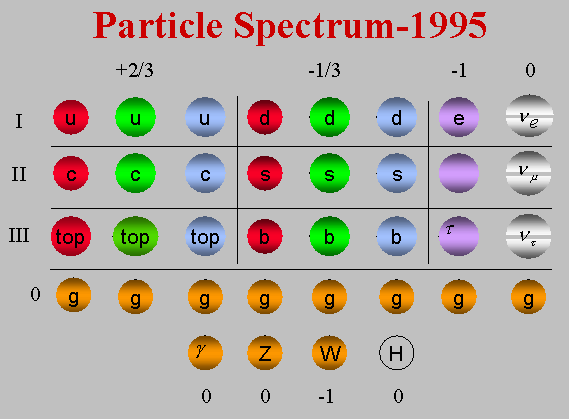
That’s the Standard Model of elementary particles. To the best of our knowledge, those are all the known particles in the Universe, accounting for everything we’ve ever interacted with directly.
However, we know there must be more to the Universe, as this doesn’t account for dark matter, for one. Furthermore, there are theoretical limitations and inconsistencies to the physics we presently know — we don’t have solutions to the hierarchy problem or the strong-CP problem — and so we suspect there’s more physics beyond the Standard Model to explain it. While the discovery of the Higgs may have finally completed the experimental confirmation of the expected particles that our best physics theories predict, we’re always trying to push the frontiers, and that means looking for any result that deviates from what the Standard Model predicts.
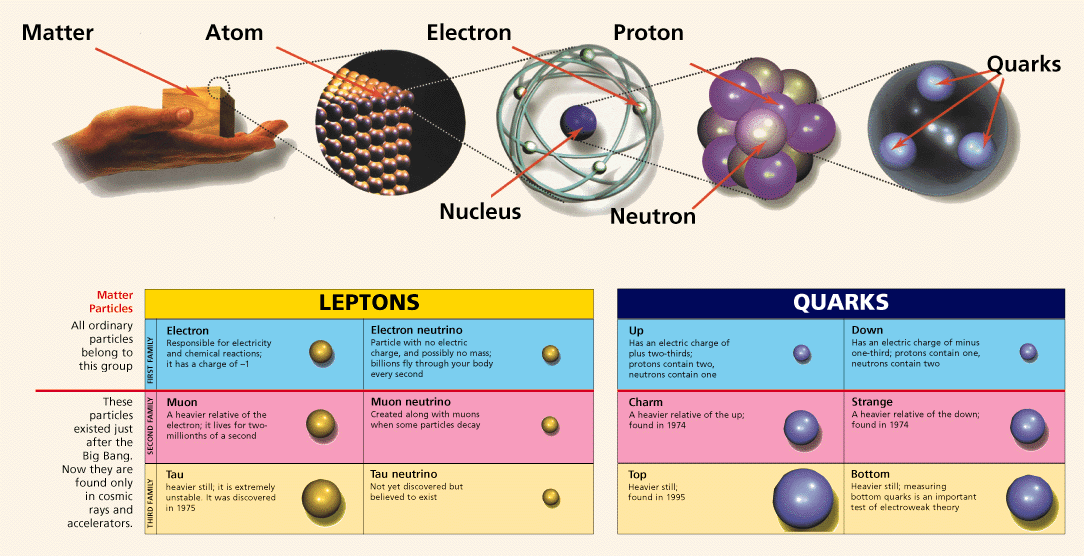
While the first “generation” of particles — the one that contains the quarks that make up the proton and neutron, as well as the electron — doesn’t have any surprises so far, the second generation does! Let’s take a look at what might just be our first window into the future of physics.
Every one of the electrically charged particles in the standard model — the quarks, the charged leptons and the W-bosons — all have not only an electric charge, but also a fundamental spin, or an intrinsic angular momentum. In our macroscopic world, whenever anything with an electric charge either moves or rotates, it creates a magnetic field. Although nothing needs to technically be “spinning” or rotating at a quantum level for this to happen, all the particles named above also have intrinsic magnetic moments as well.

We know that the magnetic moment for every particle should be directly proportional to the spin and the charge, that it should be inversely proportional to its mass, but then there ought to be a constant — known as g — that’s specific to each particle.
Back in 1928, Paul Dirac derived the very first prediction of what this constant ought to be for all of the charged leptons and quarks, predicting that for the electron (and, by analogy, the muon and tau), g should equal 2, exactly. When g was, in fact, measured to be 2, then 2.0, and then 2.00, Dirac was hailed as a genius, and won a Nobel Prize for his work on relativistic quantum mechanics.
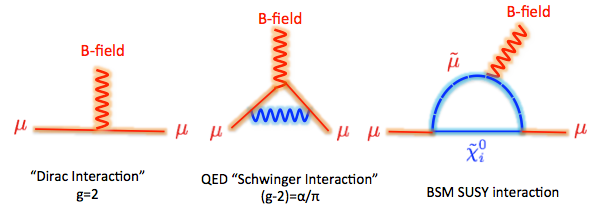
But relativistic quantum mechanics wasn’t the whole story, because it’s wrong to think of quantum particles (or waves) without thinking about the quantum field nature of the entire Universe! In addition to simply particles and the magnetic fields intrinsic to them, there are also all the other particles of the standard model which can interact with them, including self-interactions, that contribute to the intrinsic magnetic field.
The “second” diagram, above, shows the first correction to the “g = 2” prediction of Dirac, first calculated by Julian Schwinger in one of the first practical applications of quantum electrodynamics. His first-order correction to g, that it should be 2(1 + a), where a = the fine-structure constant (α) over 2π, is engraved on his tombstone.

There have now been much higher-order corrections calculated, and also g has been measured incredibly precisely for the electron and the muon (and less interestingly, for the proton and neutron as well). For the electron, g is known to be 2.00231930436146, one of the most precisely measured quantities and fantastically in agreement with the theoretical predictions.
But for the muon, which is some 200 times heavier than the electron (and hence, ~200^2, or 40,000 times more sensitive to new physics), its predicted g and its measured g are in a slight but significant disagreement!

While the muon’s g is experimentally measured to be 2.00233184178, its value is predicted, within the Standard Model only, to be 2.0023318364. These two numbers are close, but those differences are significant! To quote Thomas Blum et al. (2013):
This comparison… results in a difference between experiment and theory that ranges between 4.1 to 4.7σ.
As you can see, this difference has been around for around 15 years, and the evidence for it has grown stronger over time!
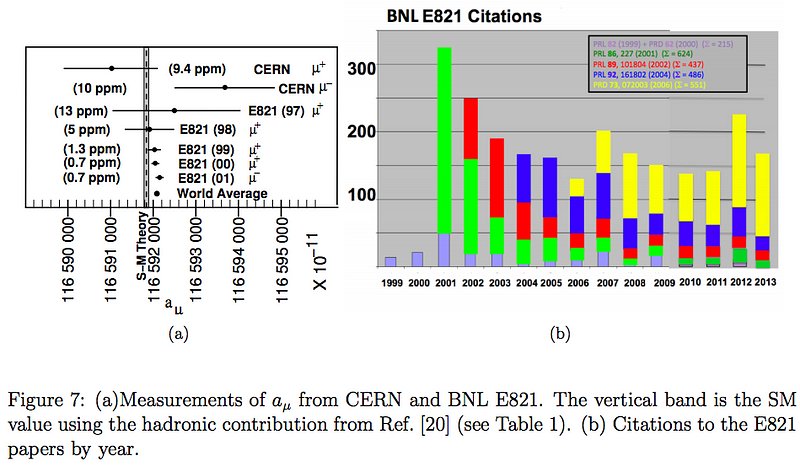
Because, as you know, 5σ is the gold standard for a scientific discovery in physics these days, we are breathtakingly close to declaring that we have, in fact, found strong evidence for physics beyond the Standard Model! Just what, exactly, that physics will be is capable of being highly constrained, as particle physics contributions to the muon’s magnetic moment are pretty much determined by what additional particles-and-interactions exist.
This is the reason, by the way, for the thousands of papers that have been written on this topic since 2001: if there is new physics beyond the Standard Model, this experiment is a great way of uncovering it and discriminating between different models!

What’s even better? The new Fermilab experiment, E989, should be capable of determining the magnitude of the anomaly, if it’s really a deviation from the Standard Model, to somewhere between 7 and 8σ! In other words, while all the world’s eyes have been on the Large Hadron Collider and its search for the Higgs (and potentially, new particles), the first true advance beyond the Standard Model may come from an experiment that few people pay attention to and a small group of theorists that have painstakingly calculated upwards of 12,000 corrections to the muon’s g factor.
And if we get lucky, this will be the piece of evidence that points out the way to uncovering physics beyond the Standard Model!
Enjoyed this? Comment at the Starts With A Bang forum on Scienceblogs!





